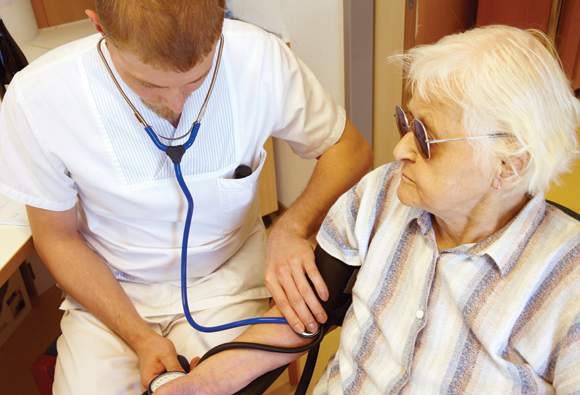User login
More than 16 million adults in the United States could benefit from a lower systolic blood pressure treatment goal of 120 mm Hg or less, as explored in the earlier SPRINT (Systolic Blood Pressure Intervention Trial) study, say researchers.
The terminated SPRINT trial showed that achieving a systolic blood pressure goal of less than 120 mm Hg in adults at high risk of cardiovascular disease was associated with a 30% relative reduction in cardiovascular disease events and 25% reduction in mortality, compared with those achieving less than 140 mm Hg systolic BP.
In a study presented at the American Heart Association scientific sessions and published simultaneously Nov. 9 in the Journal of the American College of Cardiology, researchers conducted a cross-sectional, population-based study using NHANES data from 2007-2012 to generalize the SPRINT data to a broader sample of U.S. adults with high cardiovascular disease risk and a systolic BP of 130-180 mm Hg.
They concluded that overall, 16.8 million people, or 7.6% of U.S. adults, met the SPRINT eligibility criteria, but more than half – 8.5 million – were not being treated for hypertension, including 5.2 million individuals with a systolic blood pressure of 140 mm Hg or above.
“Characterizing U.S. adults who are potentially eligible for antihypertensive treatment initiation or intensification to achieve a SBP less than 120 mm Hg may provide the health care and scientific community with information for understanding the relevance and impact of the findings from SPRINT,” wrote Adam P. Bress, Pharm.D., of the University of Utah, Salt Lake City, and his coauthors.
The study was supported by the National Institutes of Health. No conflicts of interest were declared.
More than 16 million adults in the United States could benefit from a lower systolic blood pressure treatment goal of 120 mm Hg or less, as explored in the earlier SPRINT (Systolic Blood Pressure Intervention Trial) study, say researchers.
The terminated SPRINT trial showed that achieving a systolic blood pressure goal of less than 120 mm Hg in adults at high risk of cardiovascular disease was associated with a 30% relative reduction in cardiovascular disease events and 25% reduction in mortality, compared with those achieving less than 140 mm Hg systolic BP.
In a study presented at the American Heart Association scientific sessions and published simultaneously Nov. 9 in the Journal of the American College of Cardiology, researchers conducted a cross-sectional, population-based study using NHANES data from 2007-2012 to generalize the SPRINT data to a broader sample of U.S. adults with high cardiovascular disease risk and a systolic BP of 130-180 mm Hg.
They concluded that overall, 16.8 million people, or 7.6% of U.S. adults, met the SPRINT eligibility criteria, but more than half – 8.5 million – were not being treated for hypertension, including 5.2 million individuals with a systolic blood pressure of 140 mm Hg or above.
“Characterizing U.S. adults who are potentially eligible for antihypertensive treatment initiation or intensification to achieve a SBP less than 120 mm Hg may provide the health care and scientific community with information for understanding the relevance and impact of the findings from SPRINT,” wrote Adam P. Bress, Pharm.D., of the University of Utah, Salt Lake City, and his coauthors.
The study was supported by the National Institutes of Health. No conflicts of interest were declared.
More than 16 million adults in the United States could benefit from a lower systolic blood pressure treatment goal of 120 mm Hg or less, as explored in the earlier SPRINT (Systolic Blood Pressure Intervention Trial) study, say researchers.
The terminated SPRINT trial showed that achieving a systolic blood pressure goal of less than 120 mm Hg in adults at high risk of cardiovascular disease was associated with a 30% relative reduction in cardiovascular disease events and 25% reduction in mortality, compared with those achieving less than 140 mm Hg systolic BP.
In a study presented at the American Heart Association scientific sessions and published simultaneously Nov. 9 in the Journal of the American College of Cardiology, researchers conducted a cross-sectional, population-based study using NHANES data from 2007-2012 to generalize the SPRINT data to a broader sample of U.S. adults with high cardiovascular disease risk and a systolic BP of 130-180 mm Hg.
They concluded that overall, 16.8 million people, or 7.6% of U.S. adults, met the SPRINT eligibility criteria, but more than half – 8.5 million – were not being treated for hypertension, including 5.2 million individuals with a systolic blood pressure of 140 mm Hg or above.
“Characterizing U.S. adults who are potentially eligible for antihypertensive treatment initiation or intensification to achieve a SBP less than 120 mm Hg may provide the health care and scientific community with information for understanding the relevance and impact of the findings from SPRINT,” wrote Adam P. Bress, Pharm.D., of the University of Utah, Salt Lake City, and his coauthors.
The study was supported by the National Institutes of Health. No conflicts of interest were declared.
FROM THE AHA SCIENTIFIC SESSIONS
Key clinical point:More than 16 million U.S. adults could benefit from a lower systolic blood pressure treatment goal of 120 mm Hg or less.
Major finding: More than half of the 16.8 million (7.6%) U.S. adults who meet the SPRINT eligibility criteria are not being treated for hypertension.
Data source: A cross-sectional, population-based study using NHANES data.
Disclosures: The study was supported by the National Institutes of Health. No conflicts of interest were declared.

